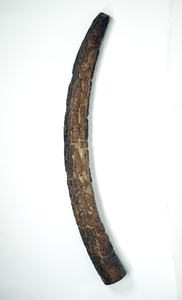Linden-Museum Stuttgart: 033284
| Linden-Museum Stuttgart: 033284 License: Attribution-NonCommercial-ShareAlike 4.0 International (CC BY-NC-SA 4.0) |
|
| Linden-Museum Stuttgart: 033284 License: Attribution-NonCommercial-ShareAlike 4.0 International (CC BY-NC-SA 4.0) |
|
Object description
This information was provided by the German museum where the object is currently located or where it was located prior to restitution.
| Object Name | Carved elephant tusk |
| Description | This enormously large elephant tusk shows most clearly the scorch marks left by the British conquest in 1897, when these objects were looted from the burning palace. At that time, 130 carved tusks were still found on the 13 ancestral altars in the courtyards. In the 18th century, the French traveler Landolphe had counted 3,000 of them. Depicted are a drummer, a bird (eating a fish), King Ewuare (supported by Crown Prince and Supreme Army Commander), Queen Mother Idia, a Portuguese (depicted very anciently with crossbow), King Ohen (pulled by two crocodiles), a braided band. Text: Dietmar Neitzke. |
| Type | Elefantenzahn |
| Materials | Ivory |
| Size, Dimensions | Length: 160 cm. Diameter: 17 cm. |
| Dating of Object |
Museum / Collection / Acquisition
This information was provided by the German museum where the object is currently located or where it was located prior to restitution.
| Museum | Linden-Museum Stuttgart |
| Museum Inv.-No | 033284 |
| Collector | Max Westendarp (Hamburg, Germany) |
| Acquisition date | 1903 |
| Circumstances of acquisition | In 1903, the German Colonial and Hunting Exhibition was held in Karlsruhe. Karl Count of Linden visited this exhibition and was interested in several objects. This also concerned this tusk. These objects were exhibited by Max and Carl Westendarp or by their ivory products company ""Heinrich Adolph Meyer"", with whom the museum then established contact. Wilhelm Deurer, Royal Württemberg Consul in Hamburg, convinced Max Westendarp to donate the objects to the Linden Museum. He had reservations about giving the objects to Stuttgart instead of his home town of Hamburg. The inventory book contains another note stating that the object was ""won"" during the capture of Benin and that it shows fire damage. In addition, 1886 is incorrectly given as the year of the conquest instead of 1897. This and other carved elephant tusks were used in 1956 as decoration in the room of the first chairman of the sponsoring association of the Linden Museum. Text: Markus Himmelsbach. |
| Notes | Max and Carl Westendarp were owners of the Heinrich Adolph Meyer ivory products company. |
Current ownership status and location
| Status | restituted |
| Date of last status change | 14 December 2022 |
| Current ownership | Federal Republic of Nigeria |
| Holding institution | National Commission for Museums and Monuments (NCMM, Nigeria) |
| Current location | Linden Museum Stuttgart (permanent loan) |
Categorization for the search functions
This information was included by the German Contact Point for Collections from Colonial Contexts and is intended to make the object easier to find in the database.
| Object Type | tusk |
| Materials | ivory |
| Tags |
Dataset
| ID | 146 |
| last Change | 2023-01-26 12:15:00 |
| License | Linden-Museum Stuttgart |

